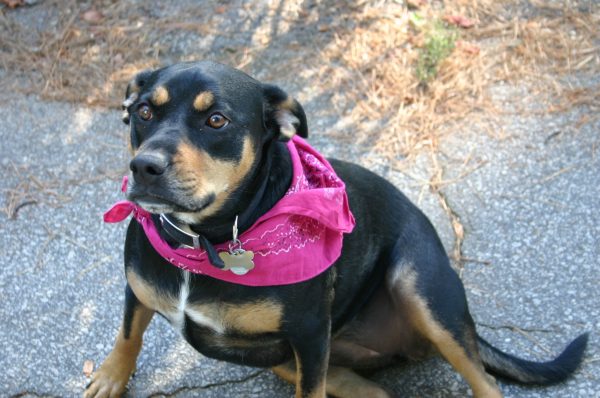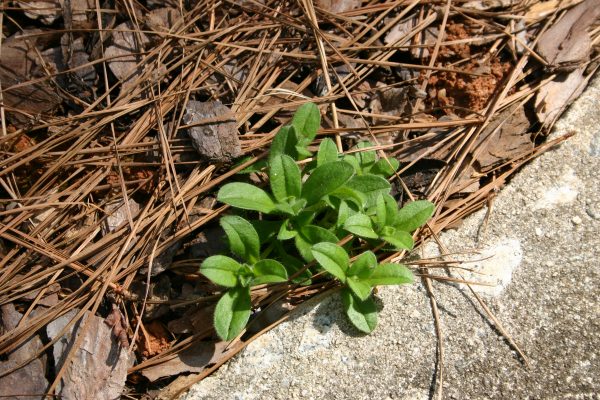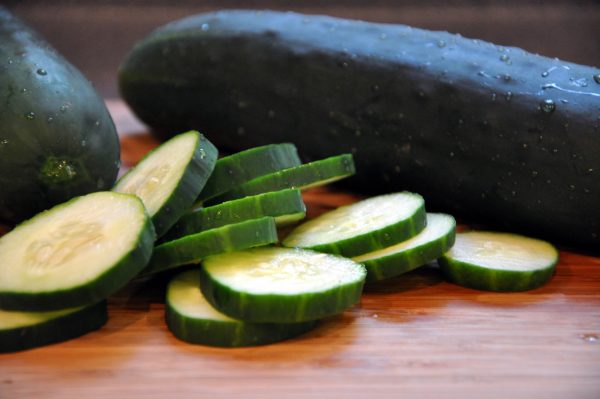Dogs – Landscaping for

If you have a dog or dogs, you know the damage they can do to a landscape. Whether digging under shrubs or pounding out a dirty path by the fence, dogs are quick to make their mark.
My colleague Sheldon Hammond collected his thoughts on landscaping for dogs.
———————————-
In my job as a County Extension Agent I frequently get calls from homeowners that are exasperated with their pets tearing up the landscaping. Their dogs are digging massive holes in and around their prized azaleas or they are trampling through the annual beds or are generally wreaking havoc on the landscape. Some of these people are looking for quick fix solutions to their problems but most are just asking – is it possible to have a good looking landscape with dogs? The answer I tell them is yes, with proper planning and plant choices.
When landscaping with outside dogs in mind, there are several factors to consider. First and foremost is to consider the dog’s traits and behaviors. The breed of the dog can offer some important information about a dog’s behavior. For example, breeds such as beagles and basset hounds are more prone to digging while other breeds such as Labrador retrievers are prone to chewing, especially when young. While there are numerous breeds of dogs with many different types of traits, there are some common ones that need to be considered for your landscape.
Don’t plant the perimeter – a dog will patrol its territory.
This is an important concept to consider, especially if the dog’s area is fenced in. A dog will cruise around the perimeter of his enclosure. This can lead to tender plants being crushed and mutilated and even the most hardy plants being trampled. A dog will also investigate every time it hears a noise – therefore other high traffic areas can be created close to walk ways, doors, gates, and vehicle parking areas. Noises from neighbors and their pets will also attract pets to the same areas in the landscape. The end results are bare compacted areas where the high traffic occurs.
You cannot change this behavior in dogs so the solution to this problem is to identify these areas and plan for them. It is normally useless to place plants directly in these areas as they will be trampled. These areas lend themselves to be open areas with landscaping along their perimeters to either hide or enhance them. To cover the bare dirt and help with the soil compaction problems, several options are available. Mulches – both organic and inorganic can be used to cover this area. I prefer to recommend large bark mulches that hold up to the traffic and are relatively easy to get and work with. Some other options include stone mulches such as rounded pea gravel. I warn people to stay away from the sharp-edged crushed stones as they can damage an animal’s feet. With both of these options replacement and some maintenance will be required over a period of time. Brick paver or wooden patios and walkways can be used if a more permanent low maintenance solution is sought.
Along the perimeter of a property, especially with a fence, a corridor for traffic needs to be maintained. A path of at least 18 inches between the fence and any landscape plants is normally recommended. This will allow the dog to be able to patrol their territory without damaging plants. Taller shrubs that will spread foliage above the height of the dog can provide greenery without obstructing the dog’s travel. If you need a year- round screen of this area, evergreen shrubbery can be full on one side and trimmed back on the perimeter side. When selecting these plants you will need tough plants that tend not to break. Some plants to consider include:
Deciduous shrubs : Berberis juliane (Barberry), Lagerstroemia indica (Crepe Myrtle), Euonymus alatus ‘Compactus’ (Winged Euonymous), Hibiscus syriacus (Rose of Sharon), Cotinus coggygria (Smoke tree), Vitex (Chaste tree), Buddelia (Butterfly bush), Forsythia x intermedia (Border forsythia), Philadelphus x ‘Natchez’ (Natchez mockorange).
Evergreen shrubs: Eleagnus pungens (Silverberry eleagnus), Ilex americana (American holly), Ilex cornuta ‘Burfordii’ (Burford holly), Ilex x attenuata (Fosters holly), Ilex x ‘Nellie R Stevens’ (Nellie R Stevens holly), Ilex vomitoria (Yaupon holly), Jasminum nudiflorum (Winter Jasmine), Juniperus chinensis ‘Hetzii glauca’ (Juniper), Juniperus chinensis ‘Kaizuka’ (Hollywood juniper), Mahonia aquifolium (Oregon grape), Abelia grandifloria (Glossy abelia), Callistemon citrinus (Crimson bottlebrush), Camellia japonica (Japanese camellia), Camellia sasanqua (Sasanqua camellia), Illicum parviflorum (Small anise tree), Loropetalum chinense var rubrum (Pink Chinese fringe flower), Myrica cerifera (Southern wax myrtle), Osmanthus fragrans (Sweet osmanthus).
If you would like to incorporate more tender or less durable plants into these areas, consider using containers and raised planter boxes for flowers. This is a very effective way to introduce color and tender plants onto decks and patios and heavily travels areas. If you need to plant in regular beds, flowers, bulbs or ground covers can be protected from dogs that lie in them by installing short rounded stakes just below the foliage. This will discourage dogs from lying in the beds. Some particular instances in the landscape like owning Labrador retrievers and installing a water garden it might be necessary to utilize some fencing to restrict the animals away from certain landscape elements in your landscape. Another use for fencing would be if you do a lot of entertaining in you garden is to install a pen with a long run that the dog may occupy when there are guests in the garden.
Young Dogs and certain breeds tend to chew on anything.
Anyone that has a dog younger than two years or a breed that has chewing tendencies needs to take into account the types of plants in the landscape. Certain plants in the landscape can be toxic and create health problems for animals. In Georgia I keep a list of things that can have a toxic affect on animals. Please note, however, that the term toxic does not imply that the plant is fatal. It is worth noting here that dogs and cats often vomit after chewing on plants; this probably does not represent “poisoning” or any dangerous exposure. Some plants may be only mildly toxic and may cause stomach ache or mild irritation of the mouth and throat when ingested. There are also a number of variables that determine how severe the poisoning symptoms may be, such as the age, weight and health status in relationship to the quantity of the plant ingested as well as the form that the plant was in at the time of ingestion (i.e., ripe fruit versus unripe fruit, etc.).
It is not intended to discourage you from planting any of the plants on the list, but to make you aware of their potential hazard when used in landscapes frequented not only by pets but by young children or mentally challenged adults. As the saying goes “an ounce of prevention
is worth a pound of cure.” Prevention is the best medicine to prevent toxic plant poisoning.
Some of the plants to be aware of are:
Azalea ( Rhododendron spp.) – all parts of this plant is toxic. Symptoms include nausea, vomiting, weakness, dizziness, breathing difficulty, and coma. Fortunately this plant has a bitter and highly unpleasant taste possibly limiting any chewing activity by animals.
Cherry ( Prunus spp. ) – the leaves, bark and seeds of this plant are toxic. Symptoms include gasping, and nervous disorders.
Honeysuckle ( Lonicera japonica ) and Japanese Trumpet ( Lonicera sempervirens ) – all parts of these plants are toxic. Symptoms include irregular heartbeat, respiratory failure and coma.
Lilies ( Zephyranthus spp.) – All parts of this plant are toxic. Symptoms include dizziness, stomach pain, collapse and can be fatal to certain livestock.
Oleander ( Nerium oleander L. ) – One of the most toxic plants in the South East. All parts are toxic. Symptoms include dizziness, convulsions, nausea and death.
Yew ( Taxus spp. ) – This plant is extremely toxic and the animal needs to eat only one tenth of one percent of its body weight to get a toxic dose. For example a 50 pound dog would need only 0.05 pounds or less than 2 ounces of the plant to get a potentially fatal dose. Both foliage and berries are toxic. Foliage more toxic than the berries. Death can be sudden without any symptoms.
Dogs Dig – It’s a fact of life
Dogs dig for many reasons such as boredom, trying to get cool, to hunt or just for fun. Most dogs just love to have a nice cozy hole to lie in. However dogs digging and the landscape usually do not mix and they can be very unappealing to the eye. There are some design solutions however, that will help with this problem. Just like the other behaviors, you cannot eliminate the digging but you can direct it to certain areas of the landscape by giving them their own areas to dig. You can plan for a nice sandy area preferably in the shade for the dog to dig. Sand is better that dirt because it is easier to deal with and sand and water do not make mud. Sand also dries more quickly and shakes off better. This planned digging area can be located in the problem area and made more aesthetically pleasing by landscaping with rocks and some tough plants or a small fence around the perimeter. The size of the area will be determined by the size of the dog. If the dogs digging area is in a bad location for your landscape plans you can relocate the area and work with the dog to start using the new digging area.
Give dogs their space and keep thing in perspective.
Probably the most important aspect in planning for dogs in the landscape is to give them their own space. Simply put, dogs are animals that need space. Space to roam and play in. Therefore just open space is important in the landscape. Also, the last thing to consider is even with the proper planning for the dog, the landscape will not be perfect. There will still be some problems. However if you make sure that you plan the landscape with the dogs in mind you can minimize the problems and have the dog and the good looking landscape. Just remember:
▸Work with the dog’s patterns of movement when placing plants.
▸Keep special plants safe with containers, raised beds and planters.
▸Give dogs a place of their own like a digging spot and places to roam.
▸Keep things in perspective – everything will not be perfect.
Further resources:
Tom Barthel has written Dogscaping: Creating the Perfect Backyard and Garden for You and Your Dog

Lola Callaway














